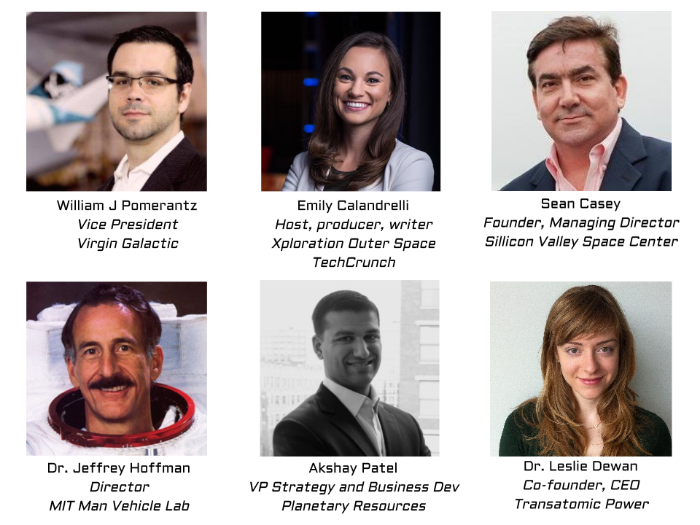Over the past few years, a new industry – Private Space – has gradually been coming of age. Space exploration is experiencing a phenomenal evolution from primarily government-funded programs such as NASA to private businesses funded by government contracts and venture capital. It is expected to spawn unicorns of the future and is increasing attracting investments. Naturally, that translates into opportunities for MBA grads. With the goal of tapping into this opportunity, MIT Sloan students launched the Astropreneurship and Space Industry Club in November 2014.
MIT Sloan’s Space Industry Conference

Speakers at MIT Sloan’s First Private Space Industry Conference
On April 9, 2016 – two days before Yuri Gagarin Day – MIT’s Astropreneurship and Space Industry Club (ASIC) hosted its first ‘Private Space Industry Conference’ to further the connection between businesses, academia, funding, and the talent pools of MIT, Harvard University, University of Chicago, and Boston University. Rightly called the New Space Age Conference, it attracted eminent speakers from all over the country who discusse myriad domains of astropreneurship and its factors like future of human space flight, space accelerators, the role of public organizations and policy makers, development of new generations of satellites, propulsion means, space habitats, and more. The conference witnessed 150 attendees from MIT, Harvard, UChicago, Yale, Penn, BU, & WPI.
The SpaceX Victory
A day before the conference, on April 8, SpaceX made history by landing a rocket – Falcon 9 – on a floating barge in the middle of the ocean. Elon Musk, the founder of the commercial spaceflight company said shortly after the landing, “In order for us to really open up access to space, we need to achieve full and rapid reusability”. The emphasis on reusability is due to the astronomical costs of rockets – to the tune of $60 million. This was SpaceX’s sixth attempt at an aquatic landing. It came on the heels of its Dec 23, 2015 achievement of landing Falcon 9 terrestrially after launching it into space.
Need For Investment in Rocket Launch Companies
Regular, reliable transportation to space is an essential factor to secure growth. “There has never been a better time to raise capital if you’re in the commercialization of space. On the other hand, until we see some exits, I think you’re going to see a slowdown,” said Richard Rocket, Co-Founder and CEO of New Space Global, a research and analysis firm tracking the space industry. He said that lesser private investment in small satellites is the key to improve space economy until launch rates go up. He said, “There are serious people serious about colonizing Mars.”
Making Mars Inhabitable: 3-D Printing
It seems inevitable that the colonization of Mars will take place. For Mars to become truly habitable, there needs to be an ability to leverage existing materials on the planet to build the basic infrastructure. Keegan Kirkpatrick’s startup, RedWorks, has developed 3-D printing technology that can use Martian soil to build roads and other infrastructure that can sustain human life. James Wolff of GoDeepSpace also talked about deploying cement 3-D printing in space.
Asteroid Mining
“We’re going to mine asteroids” was also a new procedure that was drawn to acquire essential needs like water, building materials and fuel for a pleasant stay in Mars. Akshay Patel, the Vice President of Planetary Resources described the asteroids as “low-hanging fruits” that can be utilized for the extraction of industrial metals and rare earth metals. President Barack Obama also signed a bill last November granting property rights to asteroids.
Lacking Diversity in Space
Till date, only 553 people have actually travelled to space. Virgin Galactic’s Vice President of Special Projects, Will Pomerantz, called it a “depressingly low” number. Since ninety percent constitute men, the sorrow deepens and there is certainly an urgent necessity for evolution of space economy that financially supports the dream of every individual that desires to travel away from the earth. Virgin Galactic is aiming to diversify those numbers at a cost of about $250,000 a ticket. “I’m only exaggerating a very, very little bit when I say if you’re healthy enough to ride a roller coaster, you’re healthy enough to go into space,” said Pomerantz.
Role of Aerospace Incumbents
Incumbents like Boeing may not be as much in the news as new entrants SpaceX and Virgin Galactic but they are continuing making strides to ensure their relevance. Dr. Naveed Hussain, Director at Boeing delivered a keynote speech, opening it by saying “We love MIT at Boeing.” He talked about how Boeing is collaborating with NASA to build a composite cryogenic fuel tank that will reduce the weight and cost of tanks on space vehicles. Dr. Hussain said, “The cost to access space is still a factor. It’s a huge factor in terms of closing the business case in terms of a lot of things conference attendees are working on. We’ve still got to get it into space.” The final goal is to make all materials “space-qualified” using recovery materials that will not suffer even the smallest crack.






